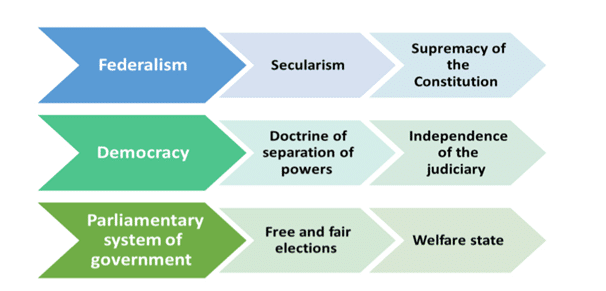Kesavananda Bharati’ judgement case
Context: Recently Kesavananda Bharati’ judgement case completed 50 years. The judgement initiated the concept of basic Structure
What is Basic Structure?
- It denotes a set of principles which links all the provisions and makes constitution an organic whole.
- Parliament is limited from making amendments which affect these core values or the basic structure of the constitution.
- In 1973, the Supreme Court passed its landmark judgment in Kesavananda Bharati vs State of Kerala.
- By a 7-6 verdict, a 13-judge Constitution Bench ruled that the ‘basic structure’ of the Constitution is inviolable, and could not be amended by
- The basic structure doctrine has since been regarded as a tenet of Indian constitutional law.
How the Conception of Basic Structure emerged?
- The Constitution of a country is the fundamental law of the land. Under some Constitutions, certain parts are immune from amendments, and are given a special status compared to other provisions.
- Since the Indian Constitution was first adopted, debates have raged as to the extent of power that Parliament should have to amend key provisions.
- In the early years of Independence, the Supreme Court gave absolute power to Parliament in amending the Constitution, as was seen in the verdicts in Shankari Prasad (1951) and Sajjan Singh (1965).
- The reason for this is believed to be that in those initial years, the apex court had reposed faith in the wisdom of the then political leadership, when leading freedom fighters were serving as Members of Parliament.
The tussle between Parliament and the judiciary
- The Supreme Court in Golaknath case (1967) held that Parliament’s amending power could not touch Fundamental Rights, and this power would be only with a Constituent Assembly.
- In the early 1970s, the enacted major amendments to the Constitution (the 24th, 25th, 26th and 29th) to get over the judgments of the Supreme Courtin RC Cooper (1970), Madhavrao Scindia (1970) and the Golaknath.
- In RC Cooper, the court had struck down Indira Gandhi’s bank nationalisation policy, and in Madhavrao Scindia it had annulled the abolition of privy purses of former rulers.
- All the four amendments, as well as the Golaknath judgment, came under challenge in the Kesavananda Bharati case– where relief was sought by the religious figure Swami Kesavananda Bharati against the Kerala government vis-à-vis two state land reform laws.
Kesavananda Bharati Judgement
- The Constitutional Bench ruled by a 7-6 verdict that Parliament should be restrained from altering the ‘basic structure’ of the Constitution.
- The Supreme Court overruled its judgement in the Golak Nath case(1967). It upheld the validity of the 24th Amendment Act (1971) and stated that Parliament is empowered to abridge or take away any of the Fundamental Rights.
- At the same time, it laid down a new doctrine of the ‘basic structure’ (or ‘basic features’) of the Constitution.
- It ruled that the constituent power of Parliament under Article 368 does not enable it to alter the ‘basic structure’ of the Constitution.
- The court did not define the ‘basic structure’, and only listed a few principles — federalism, secularism, democracy — as being its part.
| Practice Question
1. What is Basic Structure? How the Conception of Basic Structure emerged?
|




